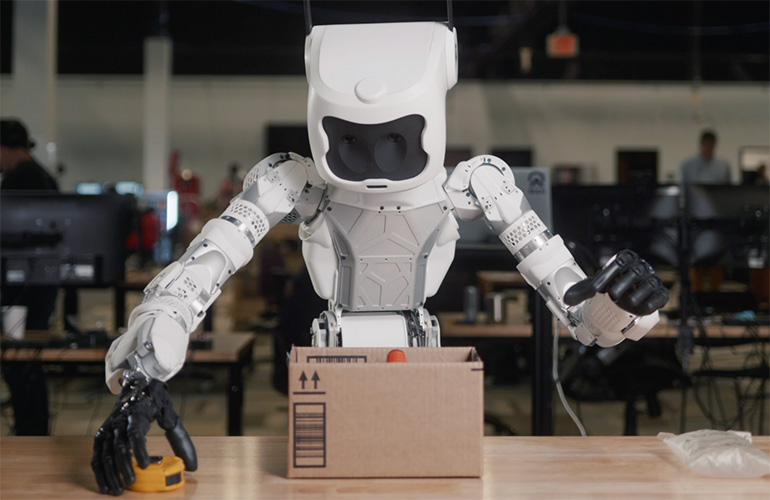|
Listen to this article  |
Apptronik launched its long-awaited Apollo humanoid robot today. The company joins a growing list of robotics companies in the race to commercialize a humanoid.
Until now, the company has had a low profile, working primarily on research and development projects with exoskeletons and bipedal locomotion for the U.S. government and the Department of Defense (DoD). While this is Apptronik’s first commercial humanoid, the company is no stranger to bipedal locomotion and humanoid development.
The company was founded in 2016 by CEO Jeff Cardenas, CTO Nick Paine, and advisor Luis Sentis out of the Human Centered Robotics Lab at the University of Texas at Austin. Apptronik has also created a commercial humanoid torso research platform called Astra in late 2020.

The Apptronik Astra humanoid torso was an R&D platform that was used to teach perception and hand-eye coordination capabilities prior to the development of Apollo. | Credit: Apptronik
The company produced and sold a handful of Astra units to research labs. Astra helped Apptronik sort out the complexities of dual-arm manipulation and hand-eye coordination while training the perception and grasping primitives that ultimately made Apollo viable.

Apollo stands 5 feet 8 inches (172 cm) tall and weighs 160 lbs (72.5kg). Capable of lifting 55 lbs (25kg), the company expects the swappable battery to power the robot for 4 hours. While no pricing has yet been announced, Cardenas said Apollo would be available for about the price of a new car.
Apollo’s strategic design was pioneered by argodesign, which created a form that balances complexity and approachability, is easy to use and work with, and is distinct and recognizable.

The Apptronik Quick Development Humanoid was a generation of robot designed to test and perfect walking algorithms. | Credit: Apptronik
Apollo represents the pinnacle of more than 13 generations of electric actuators developed by Apptronik. Cardenas is proud of the engineering in the platform as the novel design of the linear actuator in the joints will enable the company to reduce material costs while reducing complexity and improving the reliability and supportability of the system once it’s in the field. Apptronik made a strategic decision to eliminate commercially available rotary joints and motors in the Apollo humanoid in favor of its own intellectual property.
Apollo to focus on ‘gross manipulation’ tasks
We talked to Cardenas at length in episode 124 of The Robot Report Podcast, where he goes into detail about the journey to get to Apollo. A fascinating part of the conversation centered around the first applications for Apollo and humanoids in general.
Apptronik plans to deploy Apollo first into warehouses for moving boxes, totes, and crates using what Cardenas calls “gross manipulation.” These tasks involve moving items that can be picked up without the requirement of a fully dexterous hand and wrist. Limiting Apollo to gross manipulation applications is one of the decisions enabling the company to launch the product today.
“We’ve partnered with some folks that are really pushing the boundaries on dexterous manipulation,” said Cardenas. “And we’ve also purchased hands from groups that are building more affordable robotic prosthetics.” He doesn’t see hand development as the secret sauce for the company and isn’t opposed to partnering in the future with other companies focusing on hand development.

Apollo will eventually be outfitted with dexterous hands, but the initial applications will only require a simple 0-1 DoF hand. | Credit: Apptronik
“Long term, a humanoid has to have hands,” Cardenas said. “Most of the work that humans do out in the world today does involve some level of dexterity. But the exciting thing for us in terms of where we can apply the robots today with the technology that exists today, is in sort of the gross manipulation domain, meaning things where you’re using two hands to grasp something at once”.
Here’s how Cardenas described the target market for Apollo.
“We want to build a general-purpose robot that can do many of the tasks that humans can do, that can do all the tasks that we don’t want to do, handle all the tools we handle, operate in the same environments we operate in and do a wide range of tasks. But before a system can be general purpose, it’s at least got to be multipurpose. [This means] before it can do everything, it’s at least got to do three to four tasks in production out in the world. It’s got to at least do one of those tasks reasonably well, at a rate that provides positive ROI and all the things that our customers are looking for.”
Safety a top priority
Apptronik puts a major emphasis on safety. In the development of its exoskeletons, the company is familiar with the requirements of having a human inside of a robot. Apollo will use its vision perception and force sensing to slow down as humans get closer to the robot, similar to the operation of several collaborative robots. Apollo can come to a stop if a human gets too close. If Apollo gets tripped up and starts to fall, it has a safety procedure to “curl up” and limit any damage to both the robot and the surrounding environment.
“Ultimately, humanoids have to be collaborative to deliver on the value proposition,” Cardenas said. “So they have to be able to work with and around humans, and human spaces out in the real world, in all the environments that we’re operating in.”
Credit: Source link


Comments are closed.